
Download the PDF of this article
Climate change will affect our youngest children more than anyone else. It makes sense for nurseries and other early years settings to think hard about how the resources they use may be contributing to global pollution.
Throwing out plastic toys is not necessarily the way forward. Many are very robust, and while they will contribute to landfill in the future, it is probably kinder to the environment to get the most use out of them that you can. Recycling and repurposing resources and buying second-hand is key, as is keeping the environment in mind when making new purchases.
From outdoor play to mark-making, the book corner to the sand tray, there are steps practitioners can take to make sure they are supporting children’s futures in more ways than one. Look for products which are durable, ethically produced, have a low carbon footprint and minimise waste.
Purchasing decisions will be driven by a number of concerns. For example, a product may be natural and eco-friendly but may also be made in another country, which would increase its carbon footprint through its delivery.
BABY ROOM
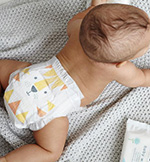 The sheer amount of disposable nappies nurseries can get through makes the baby room the obvious place to start making changes. Tops Nurseries recommends real cloth nappies from Loving by Nature (www.lbndorset.com), while Woodlands (see box) recommends biodegradable Kit and Kin nappies (www.kitandkin.com).
The sheer amount of disposable nappies nurseries can get through makes the baby room the obvious place to start making changes. Tops Nurseries recommends real cloth nappies from Loving by Nature (www.lbndorset.com), while Woodlands (see box) recommends biodegradable Kit and Kin nappies (www.kitandkin.com).
Wooden teething toys and rattles are produced by companies such as Glückskäfer and Bajo, and available from suppliers such as Babipur (www.bapipur.co.uk).
ARTS AND CRAFTS
Children can get through arts and crafts resources at a rate of knots, so this is a good place for a setting to start thinking about how they can be more environmentally friendly. Look for products that are recycled or chlorine-free, and are Forest Stewardship Council (FSC)-certified – this guarantees that the trees that are harvested are replaced or allowed to regenerate naturally.
Nurseries can get through swathes of sticky-backed plastic, all of which ends up in landfill. Childminder Millie Colwey recommends switching to plastic-free paper tape. She sources hers from Anything But Plastic (www.anythingbutplastic.co.uk). It is made from 100 per cent recycled paper and is biodegradable.
‘I buy my other art supplies from Conscious Craft,’ she says. Conscious Craft (https://consciouscraft.uk) stocks eco-friendly paint made from earth, and OkoNorm felt-tip pens and pencils made from recycled newspaper.
As a microplastic, standard glitter is made from etched aluminium bonded to polyethylene terephthalate. A recent study showed up to a third of fish caught in the North Sea contained microplastic particles, including glitter.
Early Years Resources (www.earlyyearsresources.co.uk) and TTS (www.tts-group.co.uk) stock Craft Bio-glitter, which uses plant-derived material as its basis and will biodegrade in the natural environment. Hobbycraft (www.hobbycraft.co.uk) also stocks biodegradable glitter, but bear in mind this is not suitable for children under 36 months.
It cannot be denied that eco glitter is a lot more expensive than standard glitter, although as demand rises, suppliers hope that prices will fall. Some nurseries prefer to make their own, using salt, sugar or fine coloured sand.
CONSTRUCTION PLAY
Early Years Resources sells the Green Toys Eco Block Set and BioBuddi Building Blocks. The Eco Block Set comprises 18 bold-coloured, lightweight blocks made from recycled plastic, packaged with recycled and recyclable materials and printed with soy inks. BioBuddi Building Blocks are made from left-over sugar cane instead of oil. The blocks are compatible with other building block brands and are suitable from 18 months.
Traditional wooden blocks are of course available from any number of suppliers – look for FSC certification. TTS supplies Bamboo Building Blocks in a number of shapes – bamboo grows rapidly so is a good choice for sustainable play.
ROLE PLAY AND SMALL WORLD
Childminder Debbie Hendrick has started to change her resources to wooden and natural items. ‘I have visited car boot sales and charity shops to get real things for the home corner,’ she says. It is important to ensure items are clean, robust and have no broken parts that could cause injury or small parts that could be swallowed.
Another alternative is the use of wooden and natural items. ‘I also love Grimm’s and Grapat for their open-ended wooden toys, and I have a few handmade wooden toys by Island Dreams Crafts,’ says Ms Hendrik. ‘I collect stones, shells, pine cones and so on for natural items both inside and out. There is still a place for plastic, but I have put a lot of thought into my set-up and, as a childminder, I now find that the toys look beautiful in my home even when I’m not working!’
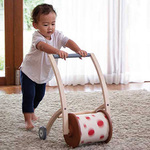 Plan Toys produces a range of wooden food (www.plantoys.gr) as well as other role play accessories such as a laundry set, dentist set and dressing-up clothes. Everything is ethically made in Thailand from rubber trees that no longer produce latex, non-formaldehyde glue, organic colour pigments and water-colour dyes.
Plan Toys produces a range of wooden food (www.plantoys.gr) as well as other role play accessories such as a laundry set, dentist set and dressing-up clothes. Everything is ethically made in Thailand from rubber trees that no longer produce latex, non-formaldehyde glue, organic colour pigments and water-colour dyes.
Many products are made from Planwood, an eco-material made by compressing sawdust, and all toys come packaged in recycled, non-toxic packaging that can go straight into the recycling. The company is based in Greece, but products are available through UK suppliers such as Babipur, Kidly and Conscious Craft.
Early Years Resources also offers a range of wooden and natural products for role play, including kitchens, food sets and a bio coffee and dinner set, made from sugarcane; the set is neutrally coloured and recyclable.
OUTDOORS
When it comes to the great outdoors, Educational Play (www.educationalplay.co.uk) provides wooden playground equipment, castles, shelters and playhouses. An obstacle trail includes wooden stepping stones and different shaped holes to crawl through. The company uses wood from fully accredited Forestry Stewardship Council suppliers, and operates with sustainable practices such as heating its workshops with a woodburning stove fuelled by excess wood from its own products.
Green Scheme (www.greenschemeltd.co.uk) offers sustainable playground products made from recycled rubber and plastics in London and the South-West.
Sand and water are natural materials, but children often play with them in plastic containers. Kedel (www.kedeleducation.co.uk) provides a range of recycled plastic products including sand and water trays, sand-boxes, gardening exploration tables and play dens.
Willow dens make a natural alternative to plastic playhouses. TTS supplies a range of huts, dens and teepees made from willow, while Willows Nursery (www.willowsnursery.co.uk) provides playhouse kits so settings can make their own dens from living willow.
BOOKS
Young children are often eager to find out more about helping the environment. Here are some books recommended by nurseries and childminders which can harness that  enthusiasm:
enthusiasm:
10 Things I Can Do to Help My World by Melanie Walsh (Walker Books). A gentle reminder of the easy, everyday ways we can be kinder to the earth, such as using both sides of the paper when writing or drawing.
Duffy’s Lucky Escape by Ellie Jackson (Ellie Jackson Publishing). One of a series of Wild Tribe Heroes books: gentle and engaging true stories about animals that find themselves in trouble when their lives are affected by plastic in the oceans.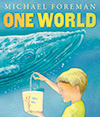
One World by Michael Foreman (Andersen Press). A brother and sister take out creatures and plants from a rock pool, but when there is nothing left but a slick of oil, they realise how their actions impact upon everything else.
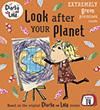 Charlie and Lola: Look After Your Planet by Lauren Child (Puffin). As Lola tidies her room, Charlie explains that ‘if we don’t use things again, in the end we will just run out of everything’.
Charlie and Lola: Look After Your Planet by Lauren Child (Puffin). As Lola tidies her room, Charlie explains that ‘if we don’t use things again, in the end we will just run out of everything’.
School children like Greta Thunberg are leading the fight against pollution and climate change. Settings can support the next generation of climate change activists through role-modelling environmentally friendly choices and sustainable living.
CASE STUDY: Woodlands Early Learning, Southampton
 Clare Moore, manager at Woodlands Early Learning, was walking through London with her senior management group last Christmas. They stumbled across the Sky Ocean Rescue pop-up shop, with its devastating information about how plastics are contaminating oceans. ‘After that it was all we talked about, and when we reopened in January we wanted to launch an 18-month campaign to become eco-friendly,’ she says.
Clare Moore, manager at Woodlands Early Learning, was walking through London with her senior management group last Christmas. They stumbled across the Sky Ocean Rescue pop-up shop, with its devastating information about how plastics are contaminating oceans. ‘After that it was all we talked about, and when we reopened in January we wanted to launch an 18-month campaign to become eco-friendly,’ she says.
Four staff have been appointed eco-warriors, responsible for their rooms. The setting audited its use of resources to find out where changes could be made. ‘The first was our nappy consumption,’ says Ms Moore. ‘Every single one we have ever used is still around – it will not have decomposed.’
 The nursery now uses biodegradable nappies from Kit and Kin (www.kitandkin.com), which decompose in three years.
The nursery now uses biodegradable nappies from Kit and Kin (www.kitandkin.com), which decompose in three years.
Another focus has been arts and crafts. ‘We intend to make all of our art rooms plastic-free, and have started with our baby art room,’ says Ms Moore. ‘We are learning how to make natural paints and eco-friendly glitter, and we make confetti out of coloured paper punches. Our paint trays are all metal – upcycled muffin trays – and our glue pots are stone tealight-holders. Our paintbrushes have wooden handles and natural bristles.
‘We don’t ask parents for junk modelling items like we used to. Once you add paint or glitter to a cereal packet or plastic bottle, that is no longer recyclable, so we are using up what we have in the nursery and encouraging parents to recycle their own paper and plastics.’
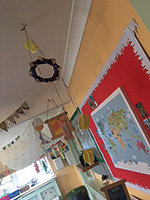 Sticky-backed plastic has been banned – children’s art is mounted on hessian to be displayed.
Sticky-backed plastic has been banned – children’s art is mounted on hessian to be displayed.
‘We recently changed all of our water and baby bottles to stainless steel and silicon, and set staff a challenge to upcycle all of the bottles,’ Ms Moore says.
Furniture is constructed from pallets sourced from local companies. Children have been presented with canvas bags to keep their changes of clothes while at nursery, instead of plastic bags. The setting is also currently looking at replacing plastic toothbrushes with bamboo ones. ‘Our toddler room now has our first natural sensory area, with wicker baskets as containers and wooden toys,’ says Ms Moore.
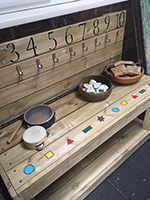 ‘We are only one nursery, but if you have 495 children, that’s 495 families learning about what we are doing, and if they just tell one other person, that is 1,000 people,’ she concludes. ‘For these children, supporting the environment will be something they have always done.’
‘We are only one nursery, but if you have 495 children, that’s 495 families learning about what we are doing, and if they just tell one other person, that is 1,000 people,’ she concludes. ‘For these children, supporting the environment will be something they have always done.’
Woodlands is happy to answer questions: email clare@earlyroots.com
TOP TIPS
(Thanks to Woodlands)
- Show staff the reality of the plastic in the ocean and other
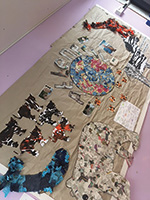 environmental issues to get them on board.
environmental issues to get them on board. - Nominate ‘Eco Warriors’ to evaluate your setting with fresh eyes.
- Explore Pinterest for ideas.
- Dedicate time to think how to make your early learning idea or activity eco-friendly.
- Make small, steady changes.
- Contact your suppliers asking how they can support your cause.
- Link up with other companies aiming for the same thing.
- Contact local companies to donate resources to you.
- Consider bulk buying with other settings.
RECOMMENDED BUYS
Paper tape– Anything But Plastic’s 100 per cent recycled paper is completely biodegradable.
Craft Bio-glitter – uses plant-derived material as its basis and will biodegrade in the natural environment.
Grimm’s Large Rainbow – the 12 blocks can be used in a myriad of ways. Made from wood sourced from sustainably managed European forests.
https://www.babipur.co.uk/grimms-rainbow-twelve.html
 Bamboo toothbrushes – by Eco Ezee. Bamboo is the world’s fastest naturally renewing resource and is also inherently anti-microbial, anti-fungal and anti-bacterial.
Bamboo toothbrushes – by Eco Ezee. Bamboo is the world’s fastest naturally renewing resource and is also inherently anti-microbial, anti-fungal and anti-bacterial.
Fairy House – Island Dreams Crafts encourages imagination in small-world play.
The Sustainable Early Years Facebook group is a great place for settings to share information on good practice.









